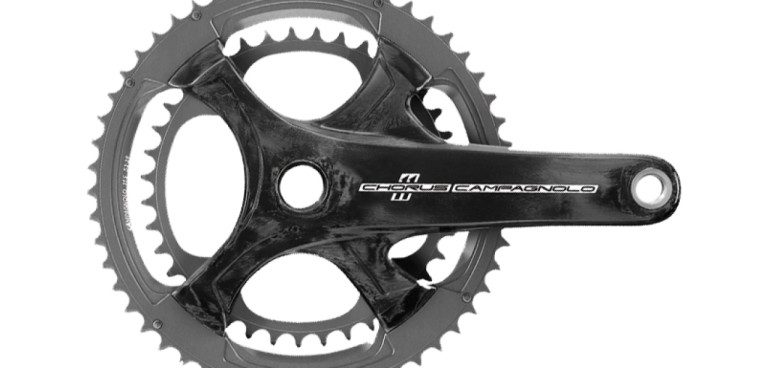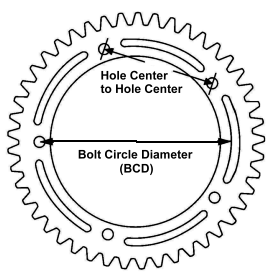Worn out your chainrings? Or just looking to tweak your gears a bit? This buyers guide will help you work out what’s what.
Chainrings are the parts with the teeth on the chainset over which the chain passes. They can wear out over time but they are available to buy individually. You don’t have to buy a whole new chainset just because a chainring has worn out.
Chainrings are quite easy to replace too. Check the ‘tools you need’ section at the end of this blog.
The majority are made from aluminium. Aluminium is light weight and relatively long lasting. Steel is used on some smaller rings for increased longevity, especially on touring bikes with triple ring chainsets.
Carbon and even titanium chainrings are available but they are rather expensive.
All about the teeth
Rings are supplied with different sizes with different amounts of teeth. The more teeth, the bigger the chainring.
The number of teeth affects how much effort is needed to turn the pedals. The larger the chainring the more rotations of the rear wheel you’ll achieve by a single rotation on the front chainring.
Basically, large chainrings are for going fast and/or riding on the flat or on downhills. Smaller chainrings are for going up hills.
Smaller rings go closest to the frame while larger rings go furthest from the frame. This is the arrangement that the front derailleur and the rear cassette is designed for.
Spiders and bolt circles
The two main determinants on which size of chainrings you can use is the spider type and Bolt Circle Diameter (BCD).

Cranks have either four or five bolt chainring attachment know as the spider. You can’t run 5-bolt chainrings on 4-bolt cranks and vice versa. Newer chainsets are 4 bolt while everything else is 5 bolt.

BCD is the diameter of the imaginary circle made up by the bolt holes on the spider/chainring. BCD is different between compact and standard chainrings.
Compacts use a smaller BCD – usually 110mm – which allows them to use rings with fewer teeth. Standard cranks have a larger BCD – usually 130mm – which limits the smaller chainring that fits on them to a 38 tooth. It also means you can go up to 55 teeth on the outer.
Shimano recently made the BCD the same on their newest compact and standard cranks. This allows more sizes of chainrings to be used, making it handy for swapping to lower gears if needed.
Handily, BCD is usually cleared displayed on chainrings. So have a look at your existing chainring if you need clarification.
Compatibility
As well as getting the correct spider and BCD, you need to check which brand the chainring is compatible with ie. Shimano, Campagnolo or Sram. They are all a bit different.
Ring limitations
The type of chainset you have will determine which chainrings you can use.
Single ring cranks must use a dedicated single ring. Single chainrings are available in sizes from 38T upwards. These rings usually have taller teeth and don’t have any shifting ramps and pins. These rings are different depending if it’s for track or cyclocross so check before purchase.
Standard double cranks – the most common combination is 39 tooth inner and 53 tooth outer. Older chainrings will be 42T inner and 52T outer. The smallest inner chainring possible is to 38T. The largest outer chainring possible is 55T (without changing to a different front mech).
Compact double cranks – normally 34 inner and 50 outer but Shimano are now championing 36 inner and 52 outer on non-race groupsets.
Triple ring cranks – 30/39/50T is the most common chainring combination on road bikes. Again, each chainring is sold as a specific position in this combination which cannot be changed due to chain shift ramps and pin positioning unique to each one.
Tools you need to change chainrings
It depends on your bolts. Some require two 5mm Allen keys. Most require a 5mm Allen key and a chainring bolt tool.

Some cranks may even require you remove your crank to replace the inner chainring. This isn’t too difficult these days as all it requires is usually a 5mm Allen key and possibly a pre-load tool for nipping it all back upon re-assembly (although a lot of people just improvise with a coin or similar!)

Do Kettler Alu-rad “trekking” bikes have non standard chainset measurements?. Both SRAM and Shimano replacement chainrings are slightly too small to be swap compatible to the trebble ring on the Kettler, although holes for bolts align ok.
Suggestions please ?
Measure the Bolt Circle Diameter (BCD) This is the diameter across the chainring mounting holes, and do an online search for that chainring BCD.
This page should help;
https://www.wolftoothcomponents.com/pages/how-to-measure-bolt-circle-diameter-bcd